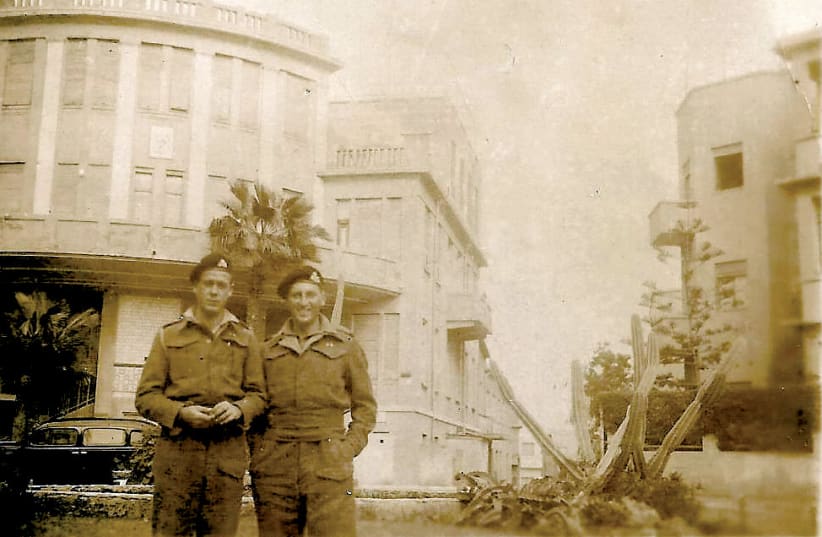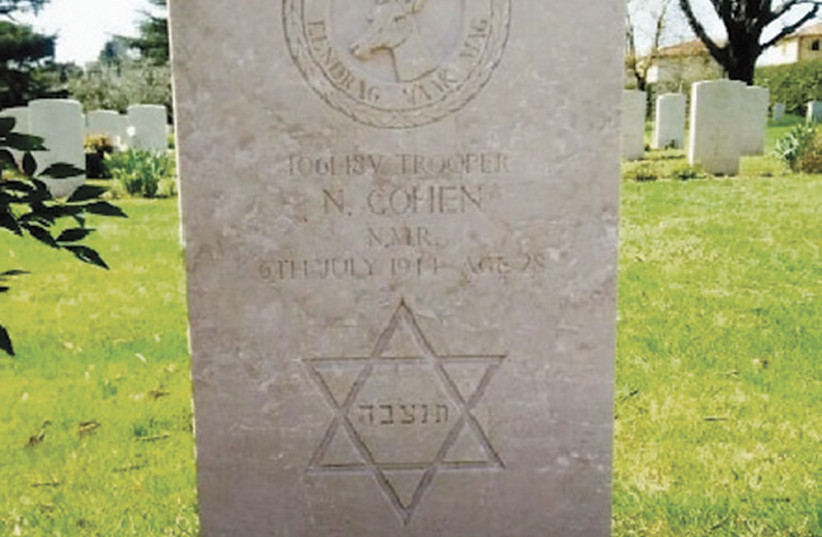No two ways about it: my Uncle Tony was a “lad.”
No good at school, but tall, handsome and well-built, Nathan “Tony” Cohen loved life, excelled at sport, and was game for any mischief going. He often recruited my Mom and their little brother Benny into his shady schemes, and just as often got them into big trouble. But they worshiped him nonetheless.
In the hot, dusty wheatland town of Malmesbury in South Africa where they grew up, Tony was everyone’s ticket to a good time.
After school, Tony drifted from job to job, usually taken on because of his natural charisma and sporting prowess rather than any particular aptitude or work ethic. Wherever he landed, he was a shoo-in for the local rugby team and on the A-list for every party.
When war was declared in 1939, he rushed off to volunteer for active service. According to his letters home during training, he could not wait to get “in the thick of it.” He served in North Africa, was captured at Tobruk, escaped, and returned to Malmesbury with severe sunburn. Later, he was shipped off to Italy as part of the 6th Army. On July 6, 1944, his unit was caught in a German artillery attack near Nebbiano, and he was killed instantly by an exploding shell. He was 28 years old.
I came into this world nine years after Tony was killed. There were silver-framed photographs of him scattered around my parents’ house. No one said much about him, but when they did, adult faces clouded over, and a profound sadness filled the room. As long as he lived, his brother Benny simply broke down at the mention of Tony’s name.
As a child, I desperately needed to fill in the gaps, and create for myself a mental picture of this legendary figure. Any image I constructed from what little I saw and heard around me was always abstract, and fleeting. My late uncle was a ghost who lived in my home. My older brother, Tony, inherited the name, but not the love of rugby.
Uncle Tony’s remains were first buried under a pile of brown Tuscan soil and marked with a simple wooden Star of David at a battlefield graveyard. Later they were disinterred and moved to the massive Commonwealth War Graves Commission (CWGC) cemetery on the banks of the River Arno, south of Florence.
In 2007, brother Tony and I visited Italy with our wives and daughters. While staying in an agriturismo south of Sienna, Tony and I chose a day to drive North and visit our uncle’s grave. Only on the highway to Florence did we realize the date: It was July 6 – the 63rd anniversary of Uncle Tony’s passing. Apart from us, the graveyard was deserted. With the gentle sound of the river in the background, we located the simple grave of our legendary uncle.
Adjacent gravestones carried detailed information about the fallen, along with heartfelt tributes from their loved ones. But the inscription on the spotless marble stone overlooking Uncle Tony’s grave was at best, Spartan.
Below the Springbok head insignia of the South African Defense Force was his force number, name and date he was killed. I recalled my mother once telling me how news of Tony’s death had brought a black curtain crashing down on his surviving family, sending my grandmother into a prolonged, catatonic state of mourning. Any attempt by the CWGC to solicit additional information from a family paralyzed with grief would have been futile. So they had done the best they could. But I needed more. I needed something tangible that reconnected him with our family. I did not want him to be a ghost anymore. And that was where my own journey really began.
Immediately on my return to South Africa, I wrote to the CWGC, inquiring whether, at my expense, Uncle Tony’s stone could be re-inscribed to include at least the Star of David and an acknowledgment of his parents and three surviving siblings. Maureen Annetts of the Inquiries Section replied promptly and explained with the best of British courtesy that the stone would have to be lifted, transported by train to the CWGC stonemasonry yard in France, re-inscribed, and then transported back to Italy.
The process would take a few years and not cost me anything. Only one problem: Such a request could only be granted if submitted or supported by a surviving first-degree relative.
At this stage, my grandparents were long gone, my Mom had passed on, and our swashbuckling soldier-uncle had died a bachelor. His only close surviving relative was his brother Benny, now 88 years old, frail and living in a retirement village in Israel. I wrote and asked his son Harold for help. Harold replied that although Benny was still of sound mind, any mention of his late brother’s name would still bring on a flood of tears.
The macabre idea of lifting his brother’s gravestone in Italy, schlepping it by train to France and back was probably more than the old man could bear. But Harold liked the idea enough to propose that he and his brother Peter would, over a period of weeks, gently introduce the subject. Hopefully, Benny would ultimately come to accept my harebrained scheme, and agree to it in principle. And so, with Annetts and the stonemasons on hold, a delicate counseling process began, and I waited patiently for news.
After a few months, Harold informed me that Benny was finally ready to support the plan. However, he just could not bring himself to sign a letter of consent. Harold would have to apply for Special Power of Attorney in order to sign the letter on his father’s behalf. When he happened to mention that his father’s health was declining fast, I was stung with conflicting feelings such as I have never known and never want to know again. Fortunately, Harold is a very wise man, and acted swiftly while deferring any dark – and fully justifiable – judgments on his South African cousin’s bizarre obsession with a gravestone in Italy.
In November 2007, I wrote again to Annetts, my letter on this occasion accompanied by a thick bundle of documents including long birth certificates, certified genealogy records, Power of Attorney vested in Dr. Harold Sgan-Cohen, and Harold’s letter written on Benny’s behalf. I decided to also include a photograph of Uncle Tony posing next to a fighter plane somewhere in Egypt, hoping that photograph would boost my brittle bona fides in some small way. Friendly and courteous as always, Annetts replied that all was in order, and advised that the gravestone would be on its way to France sometime in the next year. After that, I heard nothing more.
At this point, my life as a medical consultant, husband, father of two daughters, part-time musician and over-involved dog owner took over, and I confess that the issue of a gravestone 1,300 km away all but “dropped off the table.” Maybe Annetts had retired, or the train to France had gotten lost. Even people with obsessions eventually get weary.
Then in 2015 – eight years after my visit to Italy – I received an email from Harold. Cousin Lavi Hoffmann living in Israel had gone to pay his respects at the cemetery in Florence, and had sent a photograph. Lo and behold! There, set in a bed surrounded by manicured lawns, stood the gravestone of Trooper N. Cohen, with a beautifully carved Star of David below the Springbok head, and an inscription which read: “Always remembered son of Abraham and Leah, brother of Sonny, Benny and Berthe Bass.”
Benny had passed on by then, but I think he would have approved. I for one was overjoyed. I wrote to Annetts to express my deepest gratitude for all she had done for my family. I received a reply from a colleague informing me that Maureen Annetts had retired from service in 2012, but that my sentiments would be conveyed to her.
The war cemetery on the banks of the Arno is a beautiful, somber place. It is impossible to escape the deep sadness of so many young lives cut short by the whims of a few bloodthirsty war-mongers. But one marble stone bearing the Star of David also tells another personal story. Thanks to the dedication of a woman I never met, the resting place of an uncle I never knew is finally marked with the dignity and respect that it rightfully deserves.
And in my mind’s eye, I can see him more clearly now. ■

